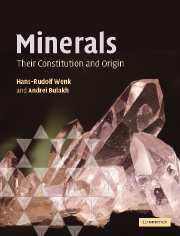Book contents
- Frontmatter
- Contents
- Preface
- Acknowledgments
- Figure credits
- Part I Structural features of minerals
- Part II Physical investigation of minerals
- Part III Variety of minerals and mineral-forming processes
- Part IV A systematic look at mineral groups
- 19 Important information about silica materials and feldspars
- 20 Simple compounds. Unusual mineral occurrences
- 21 Halides. Evaporite deposits
- 22 Carbonates and other minerals with triangular anion groups. Sedimentary origins
- 23 Phosphates, sulfates, and related minerals. Apatite as a biogenic mineral
- 24 Sulfides and related minerals. Hydrothermal processes
- 25 Oxides and hydroxides. Review of ionic crystals
- 26 Orthosilicates and ring silicates. Metamorphic mineral assemblages
- 27 Sheet silicates. Weathering of silicate rocks
- 28 Chain silicates. Discussion of some igneous and metamorphic processes
- 29 Framework silicates. Zeolites and ion exchange properties of minerals
- Part V Applied mineralogy
- Appendices
- Glossary
- References
- Index
- Plate section
- References
26 - Orthosilicates and ring silicates. Metamorphic mineral assemblages
from Part IV - A systematic look at mineral groups
- Frontmatter
- Contents
- Preface
- Acknowledgments
- Figure credits
- Part I Structural features of minerals
- Part II Physical investigation of minerals
- Part III Variety of minerals and mineral-forming processes
- Part IV A systematic look at mineral groups
- 19 Important information about silica materials and feldspars
- 20 Simple compounds. Unusual mineral occurrences
- 21 Halides. Evaporite deposits
- 22 Carbonates and other minerals with triangular anion groups. Sedimentary origins
- 23 Phosphates, sulfates, and related minerals. Apatite as a biogenic mineral
- 24 Sulfides and related minerals. Hydrothermal processes
- 25 Oxides and hydroxides. Review of ionic crystals
- 26 Orthosilicates and ring silicates. Metamorphic mineral assemblages
- 27 Sheet silicates. Weathering of silicate rocks
- 28 Chain silicates. Discussion of some igneous and metamorphic processes
- 29 Framework silicates. Zeolites and ion exchange properties of minerals
- Part V Applied mineralogy
- Appendices
- Glossary
- References
- Index
- Plate section
- References
Summary
General comments on silicates
Silicate minerals constitute over 90 vol.% of the earth's crust and are thus the most common minerals that we encounter. Like other ionic compounds, silicate structures are built up of coordination polyhedra, mainly tetrahedra and octahedra. Among the elements in the crust, oxygen (47 atomic%), silicon (28%), aluminum (8%), iron (5%), and calcium (4%) are the most abundant, and therefore minerals containing silica in combination with these other elements dominate. We have already discussed some silicate minerals in Chapter 19, namely feldspars and silica minerals. In the next four chapters we take a closer look at the large variety of silicates and their significance as rock-forming minerals.
The Si-O bond is only about half ionic, while the remainder is covalent. The covalent Si 3p3- O 2p hybrid bonds (Figure 26.1) have directional properties, contrary to the spherical symmetry of electrostatic attraction in ionic bonding. Because of this, silicates in general have low crystal symmetry, a high anisotropy of physical properties and a complex crystal structure with large unit cells. The bonds define a coordination tetrahedron SiO44-, which is the basic building unit of silicate minerals (see also Figure 19.2).
There are several important cation substitutions in silicates, on tetrahedral, octahedral and larger structural sites (Table 19.2). It is significant that some of these substitutions are between ions of different charge.
- Type
- Chapter
- Information
- MineralsTheir Constitution and Origin, pp. 425 - 447Publisher: Cambridge University PressPrint publication year: 2004



